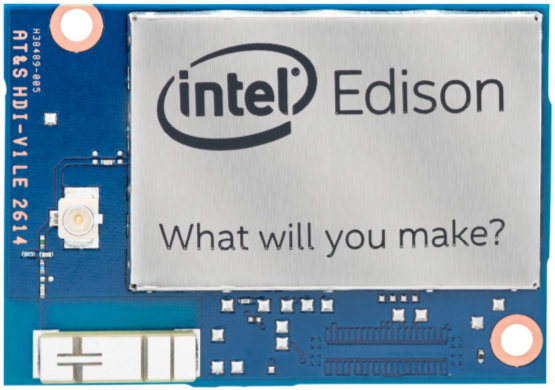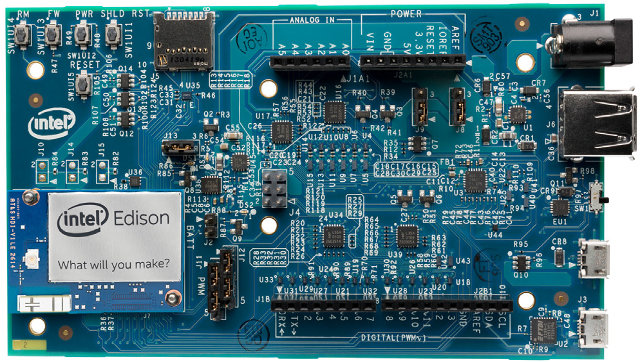Intel announced the Edison board for wearables applications last January at CES 2014. When it first came out, it looked like an SD card, but the board look has now drastically changed. Nevertheless, the important point is that Intel Edison is now available, together with various development kits, and runs Linux (Yocto built), as well as an RTOS.
 With the official release, we’ve also got the full specifications:
With the official release, we’ve also got the full specifications:
- SoC – Dual-core, dual-threaded Intel Atom (Silvermont) processor (22nm) processor @ 500 MHz and a 32-bit Intel Quark micro-controller @ 100 MHz. Includes 1GB LPDDR3 PoP memory
- System Memory – 1 GB LPDDR3 (PoP memory) – 2 channel 32bits @ 800MT/sec
- Storage – 4 GB eMMC (v4.51 spec) + micro SD card connector
- Connectivity – Dual band 802.11 a/b/g/n Wi-Fi (Broadcom 43340) with either an on-board antenna or external antenna, and Bluetooth 4.0
- USB – 1x micro USB connector
- I/Os:
- 2x UART (1 full flow control, 1 Rx/Tx)
- 2x I2C, 1x SPI with 2 chip selects
- 1x I2S
- 12x GPIO including 4 capable of PWM output
- Module connector – 70-pin connector (Hirose DF40 series – 1.5, 2.0, or 3.0 mm stack height)
- Power Supply – Input: 3.3 to 4.5 V; Output: 100mA @ 3.3V and 100 mA @ 1.8V
- Power consumption – Standby (No radio): 13 mW; Standby (Bluetooth 4.0): 21.5 mW (BLE in Q4 2014); Standby (Wi-Fi): 35 mW.
- Dimensions – 35.5 × 25.0 × 3.9 mm
- Temperature Range – 0 to 40°C
The company will provide Yocto 1.6 Linux for the two cores of the Atom processor, and the Quark MCU will run an unnamed RTOS. Development tools for the Atom cores includes the Arduino IDE, Eclipse with support for C, C++ and Python programming languages, and Intel XDK for Node.JS and HTML5 development. An SDK and IDE will be available for the Quark MCU. Intel IoT Analytics Platform is the cloud solution adopted for the board, and will be free for limited and non-commercial use.

Edison is basically a module, so it might be useful to have a baseboard, and Intel has come up with two:
- Intel Edison Board for Arduino – Board with Bluetooth and Wi-Fi, and headers compatible with Arduino UNO expect it only supports 4 PWM instead of 6.
- Intel Edison Breakout Board – Minimal board with the following key features:
- Exposes native 1.8 V I/O of the Edison module.
- 0.1″ grid I/O array of through-hole solder points.
- USB OTG with USB Micro Type-AB connector
- USB OTG power switch.
- Battery charger.
- USB to device UART bridge with USB micro Type-B connector.
- DC power supply jack (7 to 15 VDC input).
Documentation including a product brief, hardware guides for Edison board for Arduino and the Breakout board, the Arduino IDE, and the instructions to get the Yocto BSP can be downloaded on Intel’s Edison Board page.
Intel Edison is available for backorder on Sparkfun for $49.95, and Edison for Arduino and Edison Breakout Board kits are listed Maker Shed for respectively $107 and $75, but currently out of stock. There’s also a Starter Pack on Sparkun for $114.95. Shipping is expected in 6 to 8 weeks.
Thanks to David and Freire.

Jean-Luc started CNX Software in 2010 as a part-time endeavor, before quitting his job as a software engineering manager, and starting to write daily news, and reviews full time later in 2011.
Support CNX Software! Donate via cryptocurrencies, become a Patron on Patreon, or purchase goods on Amazon or Aliexpress





For $50 you only get the module. The board is another $100.
https://www.sparkfun.com/products/13097
lol, they give the ‘standby’ power consumption, but not runtime/load power draw, which is much more important. Also the power supply is not very good if it can only source 100mA.
@Jon Smirl
Nice but too expensive then. I don’t see the advantage of this over some cheaper Arduino stuff ? Maybe it’s a bit more powerful being a dual core and such but for most things and Arduino with some low power ARM should do I guess.
This $50 Edison module includes WiFi a/b/g/n dual-band and BT 4.0 LE. You don’t need to buy Intel’s carrier boards, SparkFun has quite cheaper stack-able solutions.
seems they have some things right; the SOM+baseboard approach and the stackable bus . There will be a huge market for add-ons boards. Just like in the ol’ PC days.
Make has made an unboxing video of the Edison Arduino kit.
http://makezine.com/2014/09/10/unboxing-intel-edison/
I could finally see the back of the board, and its’ now clear that you can’t do much if anything without one of the carrier boards.
Intel have made a wise move by playing on their strength and providing a higher performance low power CPU offering to the Arduino Platform. Their technology integrates relay well with the Arduino IDE. The only problem is people struggle to find a use for such technology and this really confines it to the hobbyist market. I have an Idea but I only need to use an ATMEGA328 microcontroller. If I needed more power then the Quark and Edison boards would become much needed. I could use a Microchip PIC microcontroller but it would require a few more days to get the project working. Instead of two days it would be more like a week since the electronics would need designing. The PIC microcontrollers are not too difficult to program in C. PIC assembly is also easier than the more complicate ATMEL Microcontrollers.
I don’t know why the Raspberry Pi bandwagon continually spreads propaganda about how the Raspberry is a good teaching tool for school children. Basically it’s a Linux PC. Businesses regularly donate their old computers to schools which are more than powerful for teaching programming. The Arduino and PIC Microcontrollers are good for teaching electronics. The Arduino electronics are Snap-ons so the children will not really learn electronics but will learn a little programming. You have to design the electronics more with the PIC Microcontrollers. However programming them in the C language is not that difficult.